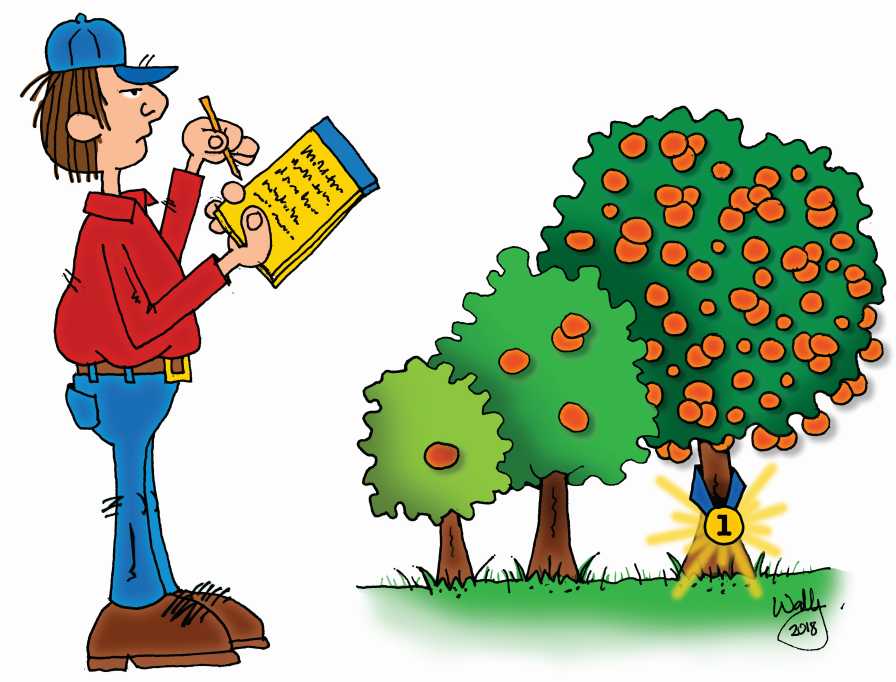Time to Shift Gears on Citrus Variety Fast Track

Graphic by Wally Edwards
The FAST TRACK model has helped move promising experimental UF/IFAS fresh citrus selections into trials and has engaged nurseries and growers much earlier in the process. At present, approximately 127 new scion/rootstock combinations are in growers’ fields under various stages of evaluation, with five selections having been elevated to commercial production (950: December-maturing, seedless, easy peeler; 914: grapefruit hybrid; RBB7-34: Navel-like, high Brix, orange hybrid; ‘Bingo’– early season, seedless, easy peeler; and ‘UFGlow’– early, seedless, easy peeler).
Though the status quo represents tremendous progress, much has changed in the industry since the FAST TRACK model launched. Some elements of the program that were intended as incentives for participation for early adopters have become impediments and factors thought to limit the potential and value of the program.
New Varieties Development & Management Corp. (NVDMC), Florida Foundation Seed Producers Inc. (FFSP), and the UF/IFAS Plant Improvement Team held two listening sessions to better understand the pros and cons of the FAST TRACK model and consider how it might be improved. Input from these meetings fueled an effort to develop an improved FAST TRACK model that better fits the needs of today’s industry.
Room for Improvement
The primary challenges of the original model were:
• Shortages of budwood, causing delays between registration and receipt of trees
• Order changes at the nursery level, mostly due to the availability of specific rootstock liners, causing complexities in documentation and trial tree availability
• Most, if not all, of the FAST TRACK selections are being patented. As such, the fee structure can be simplified.
• Grower trials were limited to 30 trees. Many growers wanted to plant more extensive trials in multiple locations, but were prohibited from doing so in order to maintain experimental use of the material.
• Growers planting trials were offered a lower royalty rate on any selection moving to the commercial stage. Additionally, these growers were granted a five-year production head start. The head start proved too restrictive and growers wishing to enter the program were prohibited from doing so. Florida needs as many growers experimenting with new material as possible. FAST TRACK promotes opportunity rather than risk.
Making Adjustments
The FAST TRACK working group suggested the following changes:
• As soon as a selection begins to show promise and the breeders are supportive of the release of the selection, UF/IFAS will propagate 100 nursery trees. This process should run concurrently with UF/IFAS and FFSP’s cultivar release and “Invitation to Negotiate” procedures. These trees will be equitably distributed to licensed nurseries through a cooperative program with FNGLA’s Citrus Nursery Division. The announcement of the FAST TRACK Suite will take place six months later. Budwood increase will be well underway by the time the FAST TRACK registration opportunity is announced.
• FAST TRACK started with three tiers. Tier I was trial. Tier II was commercial production for those growers who participated in Tier I and elected to execute a commercial agreement. Tier III was open commercial availability at a higher royalty rate after the expiration of the five-year head start. The new model combines Tier I and II. Growers are no longer capped at 30 trees. They can plant as little or as many as they wish and on any rootstock they wish. They may do small trial sites, larger trials, or commercial plantings at any scale. The only limitations are risk tolerance and nursery constraints. This puts growers in control.
• Retain the lower royalty rate for those growers who register for new FAST TRACK suites during the early registration period (first 180 days after the industry announcement) and actively participate in trial reporting and feedback. This encourages participation in the program. However, rather than close the suite to other growers for five years, the registration will convert from the lower early registration royalty rate to a higher royalty rate after the 180 days has past. Late-comers will pay a bit more to plant, but they will no longer be locked out. Those growers who do not desire to be active participants in trial reporting and feedback will access trees at the higher royalty rate.
• Recognizing that the FAST TRACK selections will be patented, removing precautions intended to preserve the patentability of the material. Growers can order trees directly from the licensed nursery of their choice. They will pay the nursery directly.
• The registration fee will increase from $50 per selection to $150 per selection to offset patent costs rather than cover this cost through royalties assessed on anticipated initial tree orders after the commercial option is elected.
• Disband the five-year head start for the first three FAST TRACK suites and allow for Tier III growers to participate when Tier II begins or when commercial interest reaches a sufficient level.
It is hoped these changes will simplify the process, improve efficiencies, minimize delays, and remove unnecessary barriers to participation. Thank you to the NVDMC Board of Directors, FFSP, the UF/IFAS Plant Improvement Team, and the FAST TRACK growers who shared their thoughts and recommendations.
The organizations represented on the NVDMC Board of Directors reviewed the proposed changes. As of this posting, Florida Citrus Mutual, Florida Citrus Packers, FNGLA’s Citrus Nursery Division, Indian River Citrus League, and Gulf Citrus Growers Association had all approved the changes. The Florida Citrus Production Managers Association had not yet convened to vote.










